BALLAMAC - COOGEE'S GRAND RESIDENCEThe earliest section of Ballamac is constructed of coarse sandstone of mid-Victorian Colonial style. The sandstone for the house was quarried from a nearby site at numbers 70 to 80 Beach street. (The steep verticle cliffs on these sites indicate their former use as a quarry). The builder and first owner was Charles Moore, c. 1860. Modern large additions have been added to east side. It was Strata titled in late 1970s into five apartments.
Charles Moore The Australian Dictionary of Biography says that in 1860 Moore built a substantial house at Coogee, and was elected to the Randwick Municipal Council, where he often led the minority Coogee faction in protests against the actions of Simeon H. Pearce of Randwick. An alderman until 1886, Moore was elected mayor in 1863. He was also a Sydney City Councillor from 1865 to 1869 and from 1871 to 1886, serving as Lord Mayor of Sydney from 1867 to 1869. In 1874 he was elected to the New South Wales Legislative Assembly for East Sydney, but he was defeated at the general election later that year. In 1880 he moved to Moore Court, a mansion he had built at Springwood. In 1880 he was appointed to the New South Wales Legislative Council, where he remained until his death at Parramatta in 1895. In the 1880's Ballamac became a hotel named the Baden Baden, some accounts say it was a boarding house. In those days, Coogee was still relatively remote from the Sydney, and the hotel was a quintessential Victorian resort where people could come and stay and take the waters.
Louis Frank - Artist A visitor to Frank's hotel in 1891 spoke highly of his hospitality and noted that he was also an amateur lepidopterology with a large collection of mounted butterflies. He was also a collector of Japanese curios which helped furnish his rooms. He maintained a separate artist's studio in the grounds of the hotel. Frank then in turn transferred the license of the hotel to a Henry Mayer in 1993, and it was announced that (The Daily Telegraph, Monday 17 April 1893 page 2, Advertising) he would be auctioning "the whole of his superb and very valuable collections of oil paintings and water colours, rare book, reptiles, foreign and Australian butterflies and numerous other choice items of great artistic interest". It was said that the sale was because of his intended departure from the colony.
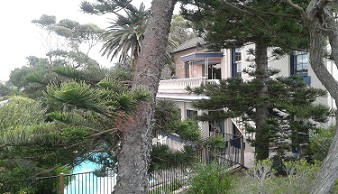
Ballamac A landscape artist who painted in NSW in the late 1880s and 1890s, Louis Frank worked mainly in oils, using a pallet knife with dexterity. He frequently produced paintings with a European influence. Many of his paintings show coastal and rural scenes. A couple that are now titled as being scenes from Coogee are obviously not of Coogee but other locations. There is, however, at least one very fine painting of Coogee Beach, pictured below. Louis Frank exhibited at the Art Society of NSW and is represented in the National Library in Canberra. Art auction records say that he was active from 1879 to 1900. His life from 1900 until he died in 1923 is a bit of a mystery. His obituary in the Sydney Morning Herald, Wednesday 12 September, 1923 page 14 simply states:
The death is announced, at North Sydney, of Mr. Louis Frank, a well-known artist many years ago, at the age of 93 years. Devoting himself largely to landscape work, Mr. Frank figured prominently in art circles in Sydney about 30 years ago. He was a member of the old Royal Art Society many years ago. The Daily Telegraph, (Wed 12 Sep 1923 Page 10) noted that he was 93 years old, never married, and had come to Sydney about "forty years ago" from India. He travelled widely in search of subjects for his art including the South Coast, New Zealand and India.
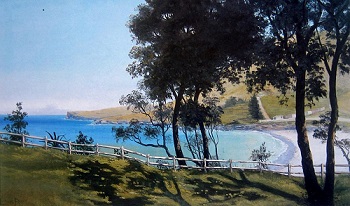 Louis Frank Painting of Coogee Beach
Madame Teleky
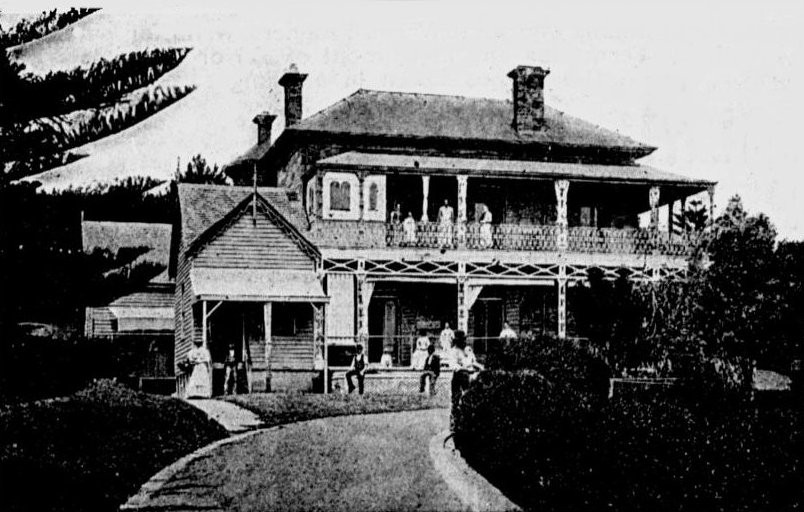 Baden Baden Hotel, Coogee in 1897 Madame Teleky, an attractive woman with exotic European origins and a hint of Royal connections, gave the hotel and an air of glamour. An advertisement in the Sydney Mail in May 1897 outlined her plans for the hotel:
The Baden Baden Hotel, Coogee Bay. Under entirely new management. Thoroughly Renovated and Newly Furnished. This hotel is, without exception, the most delightfully situated, in Eight Acres of Grounds. Wedding and Picnic Parties provided on Shortest Notice by Telephone or otherwise. Dinners, Luncheons, and Teas always ready. Banquets a specialty. French Cuisine, Best Brands of Wines and Spirits guaranteed. Boarders and Visitors at Moderate Charges. French and German spoken. Special Terms for Permanent Boarders. Apply to the new Leasee, Madame O. E. TELEKY. Telephone No. 76 Around 1903 Madame Teleky had relinquished her management of the Baden Baden and had taken on the Bulletin Hotel, which she renamed Hotel Alexandra, at 34 Elzabeth Street, Sydney. She died in 1934 and was buried at nearby Waverley Cemetery. The popular yellow press, like The Truth newspaper like to hint that there was some scandalous ill-repute about her. It sold newspapers. But the facts seem to indicate that though flamboyant, she was just a good businesswoman notable because she succeeded in what was normally a man's world.
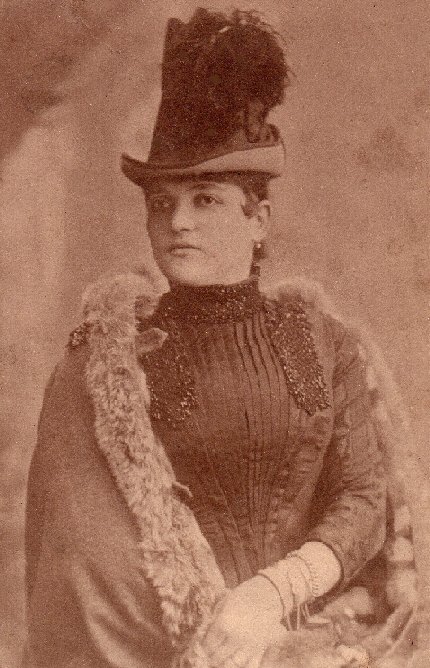
Madame Otilie Teleky
James Joynton-Smith He was cremated at Northern Suburbs Crematorium the following day. He was survived by his third wife and a daughter and a son (his eldest child, Thayre, died in 1938, aged 31). His estate, valued at £326,000, was the subject of a long and expensive litigation.
Prince of Wales Stays
Reginald Stuart-Jones - Colourful Racing Identity During his time in Sydney from 1930, he was a specialist in gynaecology in Macquarie Street and was rumoured to have run a profitable abortion practice. He frequented underworld dives and associated with underworld figures, and owned night clubs, a string of racing greyhounds and racehorses. During World War II Jones allegedly plied drugs and black-market liquor to American servicemen from his yacht, Sirocco, which was also used for parties. In 1944, he was kidnapped by underworld figures Scotty Jowett and Clifford Thompson and shot at point-blank range while in the back of Thompson's car. He found his way to hospital and remarkably recovered, and Jowett and Thompson were convicted of attempted murder. One of Coogee's most notorious residents, he died in the house on 10 June 1961. His family converted the house to strata title in 1978 when his daughter, Ms S. Stuart-Jones, was in residence. The grounds were also sub-divided so that the house was now orientated to Arcadia Street (No. 39), and 12 storey block of units built on the Baden Street frontage (No. 23) which are named Faimer Gardens.
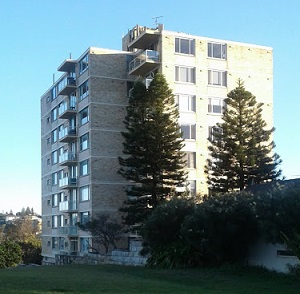
Faimer Gardens, Baden Street, Coogee
Development Proposal
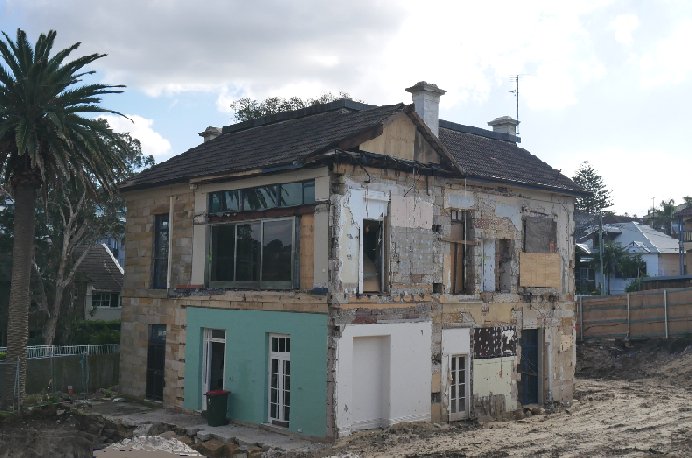 Sandstone core of Ballamac, May 2024 You can read more about Ballamac by going to Footpath Mystery in Arcadia Street - Latimers' steel plate, which describes an interesting utility remnant associated with the building. References
|